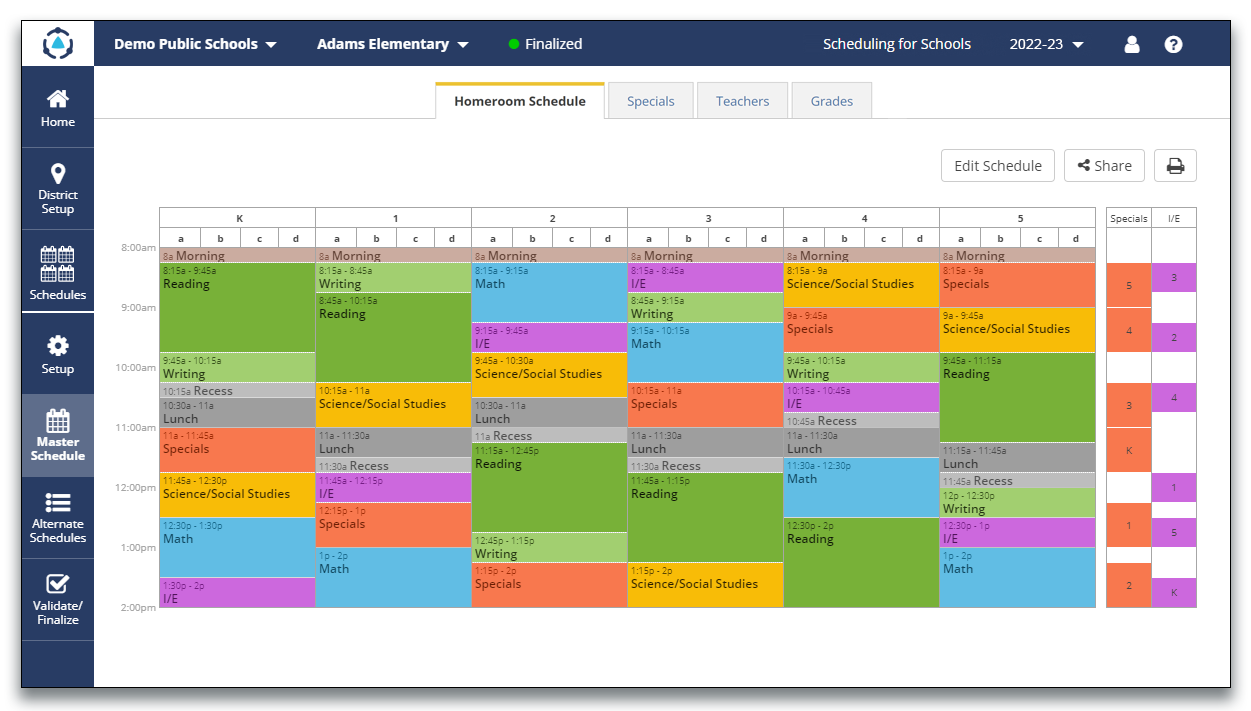
Building an Elementary Schedule - Part 3: Identifying Your Schedule's Constraints
This 12-part series on How to Build an Elementary School Schedule offers step-by-step guidance and proven scheduling strategies for creating a better elementary school schedule.
After setting goals and guidelines for instructional minutes, consider the constraints you will encounter when preparing your elementary school schedule. Make sure you differentiate actual constraints from preferences and unchallenged and/or long-standing historical practices.
Constraints are factors that you cannot control (e.g. number of rooms in your school or staff assigned to your building). Well-built schedules can often be tailored to accommodate some of the individual and historical preferences and practices after goals and constraints are managed.
Remember, you can schedule anything, but you can’t schedule everything. Having a hierarchical set of priorities, and incorporating your goals first can help clarify what will drive the scheduling and the inevitable trade-offs.
Having a checklist of constraints can be helpful throughout the scheduling process. Also, remember to consider school-to-school nuances. No two schools have the same walls, staff, or students. Remember to assess the needs and constraints of each school independently as they will likely vary somewhat from one to the other.
1. What are the requirements of your teacher contract, collective bargaining agreement, or other agreements?
There are often clauses in teacher contracts specifying how much time must be allocated for various activities (e.g. uninterrupted lunch, planning time, etc.). Make sure to review the most up-to-date documentation and understand the current terms of these agreements. Consider time allocated to a week vs. daily and other nuances. Avoid relying on anecdotal evidence as it may be outdated or inaccurate. Once these are understood, consider how the schedule will accommodate these requirements.
For example:
Can homeroom teacher planning time be accommodated during specials?
Is there an open period for specials and other teachers for planning time?
Is there a duty-free period other than specials for teacher lunches?
Is there a common planning time requirement that exceeds time allocated to specials, lunch, before/after school hours?
Is there a weekly late start or early dismissal day that can be leveraged?
2. Do you provide multipurpose spaces?
What subjects share the space (e.g. breakfast, lunch, PE, Art, Music, Band, other)? Make sure that these periods are deconflicted in advance and the transition time for setting up, tearing down/cleaning up the space is considered. This will reduce interruptions and provide proper buffer time for shared space subjects.
3. How will shared resources be used?
What is the maximum number of students that can be in the cafeteria at the same time? How will lunch waves be designed to manage this constraint?
How many spaces are available for recess? Are there grade-level space constraints or other restrictions? What is the maximum number of students that can be in each recess area at one time?
Are some specials supported by mobile solutions like “Art on a cart? Are there limitations for other shared materials (e.g. computers, tablets, instruments, software licenses, others) that limit the number of concurrent classes requiring these materials?
4. Do some teachers work part-time or are they shared with other schools?
Schools are increasingly sharing specials teachers with other schools and/or hiring part-time staff. Does your school have a specials teacher on certain days or only for a certain number of hours per week? Do you share band, orchestra, chorus, or other teachers with a secondary school? Is the school with which you share on the same or complimentary schedule rotation as yours to align needs?
5. Where is recess on incremental weather days?
Do students remain in their classrooms? Do they use the gym? If they use the gym, you’ll have to ensure recess is never scheduled concurrently with PE.
While the above may be the more obvious constraints you may encounter, identifying your schedule constraints prior to the creation of your elementary schedule will help reduce headaches later. A single overlooked constraint can send you back to the drawing board with regard to scheduling.
Need Support with Scheduling?
DMSchedules Can Help.
The key to scheduling success is preparation and planning. Start taking action now so that you and your scheduling team are well-positioned for success this scheduling season. If you need help building your elementary school schedule, reach out to us. We can take scheduling off your plate, and create your school schedule aligned with your learning goals.

